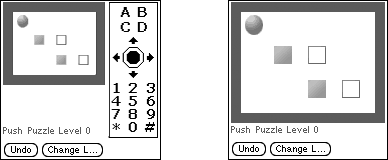Accommodating Different Screen Sizes
Relying on a particular screen size is inadvisable even for app developers who are designing an app for a specific MID. Even a single device can give an app different amounts of the screen at different times. For example, in Sun's MIDP for Palm OS, consumers can turn on app buttons or game controls, both of which impact the amount of available screen real estate. Screenshot shows the Push Puzzle game with and without the phone keypad on the screen. Changes in screen size can also take place if an app moves to and from full-screen mode.
Screenshot Unstructured Screen with and without Phone Keypad

app Developers:
Strongly Recommend:
Do not assume a particular size of device screen when designing a Canvas screen. apps that assume a particular size of screen are not necessarily portable.
Even if you assume a small screen size, your app will not necessarily be usable on all MIDs. For example, Screenshot shows a Push Puzzle game that expects a small screen. It is awkward when displayed on a mobile phone with a larger screen.
Consider: Use a scaled graphic instead of a bitmap, when possible, for graphics that will be drawn onto a canvas. Because different MIDs have different screen sizes, an app that uses a small scalable graphic and then scales it up for larger screens is more portable.
Screenshot Canvas Designed for a Small Screen on a Large Screen
